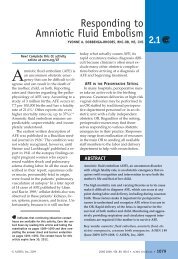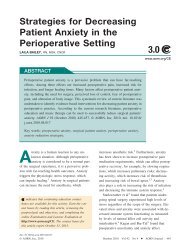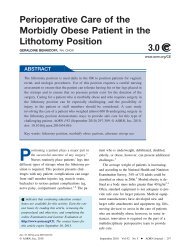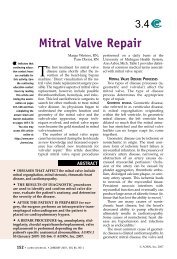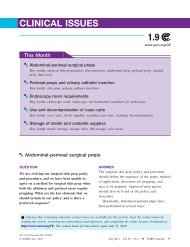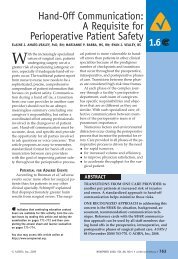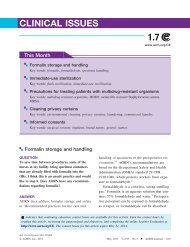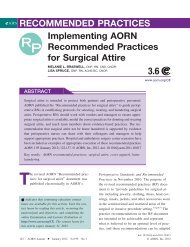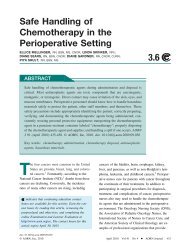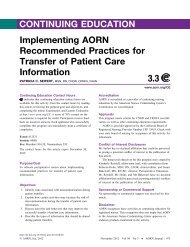The Ladd's Procedure for Correction of Intestinal Malrotation ... - AORN
The Ladd's Procedure for Correction of Intestinal Malrotation ... - AORN
The Ladd's Procedure for Correction of Intestinal Malrotation ... - AORN
Create successful ePaper yourself
Turn your PDF publications into a flip-book with our unique Google optimized e-Paper software.
Ingoe — Lange FEBRUARY 2007, VOL 85, NO 2<br />
postoperative needs <strong>of</strong> the patient. <strong>The</strong><br />
circulating nurse calls the pediatric<br />
surgical unit nurse or PICU nurse during<br />
wound closure to communicate<br />
these needs. This gives the receiving<br />
nurse time to prepare the room <strong>for</strong> the<br />
patient. <strong>The</strong> circulating nurse’s report<br />
includes<br />
• the type and length <strong>of</strong> procedure that<br />
was per<strong>for</strong>med,<br />
• the amount and type <strong>of</strong> narcotics administered<br />
during the procedure,<br />
• the antibiotics received be<strong>for</strong>e and<br />
during the procedure,<br />
• the total amount <strong>of</strong> IV fluids administered<br />
intraoperatively,<br />
• the blood or blood products administered<br />
during surgery,<br />
• whether the patient will be extubated,<br />
and<br />
• the patient’s temperature during<br />
the procedure and a current end-<strong>of</strong>procedure<br />
temperature.<br />
More in<strong>for</strong>mation may be provided depending<br />
on specific unit policies and patient<br />
circumstances. <strong>The</strong> nurse also ensures<br />
that extra support staff members<br />
are available to assist with transporting<br />
the patient.<br />
ENSURING POSTOPERATIVE NORMOTHERMIA. A<br />
child’s body temperature can drop<br />
very quickly, particularly during extubation<br />
or transport to the postoperative<br />
unit. <strong>The</strong> nurse ensures that the<br />
patient is kept warm during this time.<br />
If the child will be transported in a<br />
crib, the circulating nurse lines the bed<br />
<strong>of</strong> the crib with warm blankets immediately<br />
be<strong>for</strong>e placing the patient in the<br />
crib and keeps the patient securely<br />
wrapped in a warm blanket, papoosestyle,<br />
as much as possible. <strong>The</strong> circulating<br />
nurse also places a rolled blanket<br />
behind the patient’s back to keep<br />
the patient on his or her side to prevent<br />
aspiration if vomiting occurs.<br />
AVOIDING POSTOPERATIVE HYPOXIA. <strong>The</strong> circulating<br />
nurse ensures that a full oxygen<br />
tank is on the transport vehicle (ie, crib,<br />
bed) and easily accessible. After moving<br />
the patient from the OR bed to the transport<br />
vehicle, the circulating nurse attaches<br />
one end <strong>of</strong> the oxygen tubing to<br />
the tank and holds or tapes the other<br />
end close to the patient’s mouth and<br />
nose so that the oxygen is blowing by<br />
the patient. This is much like using a<br />
nasal cannula <strong>for</strong> an older patient. This<br />
method <strong>of</strong> administering supplemental<br />
oxygen is continued<br />
until the patient’s oxy-<br />
gen saturation level consistently<br />
remains within<br />
normal limits.<br />
If the anesthesia care<br />
provider does not extubate<br />
the patient, the circulating<br />
nurse ensures<br />
the availability <strong>of</strong> a selfinflating,<br />
bag-valve-mask<br />
resuscitator <strong>for</strong> transport.<br />
<strong>The</strong> circulating nurse obtains<br />
a portable cardiac<br />
monitor to monitor the<br />
patient’s condition during<br />
transport to the postoperative<br />
recovery unit.<br />
PROVIDING POSTOPERATIVE<br />
NUTRITION. Infants who undergo<br />
extensive intestinal<br />
resections <strong>of</strong>ten are not<br />
able to tolerate enteral nutrition <strong>for</strong><br />
quite some time. If that is the situation,<br />
total parenteral nutrition (TPN) will be<br />
started and continued long term. Children<br />
on long-term TPN will be monitored<br />
<strong>for</strong> chronic liver damage, a risk <strong>of</strong><br />
long-term TPN. 2<br />
PROGNOSIS<br />
If intestinal malrotation with volvulus<br />
is recognized and treated quickly,<br />
the patient should recover well and<br />
not have any long-lasting effects, providing<br />
there is enough bowel left<br />
to sustain life. Children who have undergone<br />
this procedure most <strong>of</strong>ten<br />
progress through life with little or no<br />
Supplemental<br />
oxygen is<br />
administered<br />
until the<br />
patient’s oxygen<br />
saturation level<br />
consistently<br />
remains within<br />
normal limits.<br />
<strong>AORN</strong> JOURNAL • 307



